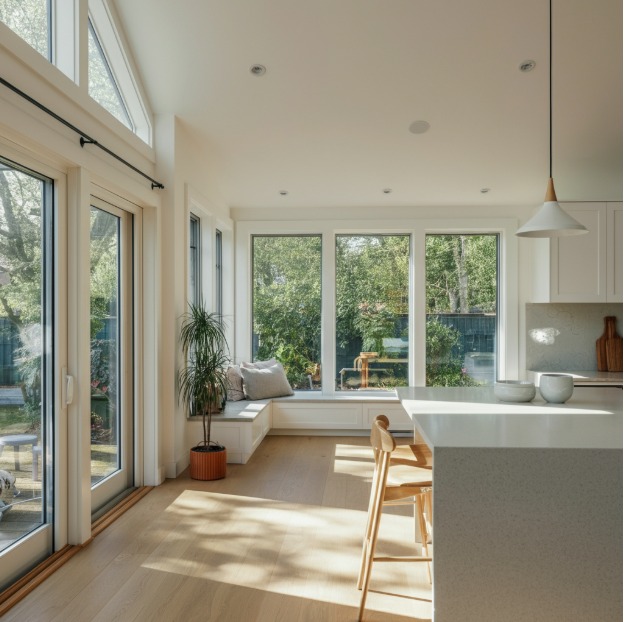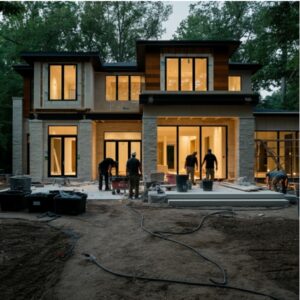Your home should be a reflection of your lifestyle, adapting to your needs as they change over time. Whether you’re running out of room or simply looking to upgrade, home additions are an excellent way to maximize your space without the hassle of moving. This blog explores the benefits of home addition services, provides insight into the types of additions you can consider, discusses how they impact property value, and offers key tips for planning your renovation. Let’s get started!
What is a Home Addition?
A home addition involves expanding your existing property to increase its livable space. Whether it’s an additional bedroom, a sunroom, or even a second story, these renovations aim to enhance both the functionality and aesthetics of your home.
Unlike minor upgrades or interior remodeling, home additions take the structure of your house to the next level. They’re perfect for growing families, remote workers needing extra office space, or anyone looking to boost their home’s value while upgrading their living situation.
What Makes Home Additions Unique?
- Customization – Each addition is tailored to your property and personal preferences, giving you complete control over the design.
- Long-Term Investment – Unlike cosmetic changes, home additions often yield a significant return on investment.
- Personalized Solutions – From multigenerational living spaces to recreational rooms, home additions adapt uniquely to your needs.
Types of Home Additions You Can Add to Your Property
Home additions aren’t one-size-fits-all. Here are the most common types of additions and why they might be perfect for your house:
1. Room Additions
A single new room can make a world of difference. Bedrooms, studies, playrooms, or even a home library can meet specific lifestyle needs without taking away from your current layout.
Pro Tip – If you’re planning to sell in the future, a guest bedroom with an en-suite bathroom is a big draw for buyers.
2. Kitchen Extensions
If your kitchen feels cramped, extending it can enhance functionality and create an open, welcoming cooking or dining space. It also allows for modern amenities like a kitchen island or extra storage.
3. Garage Conversions
Not using your garage for your car? Turn it into a guest suite, a creative studio, or a rentable apartment. This option makes use of underutilized space.
4. Sunrooms or Conservatories
Fancy more natural light? A sunroom or conservatory is an affordable way to enjoy the outdoors year-round without stepping out of your home.
5. Second Stories
Adding a second story gives your property a dramatic facelift and doubles your home’s usable space. This is particularly ideal for smaller lots where expanding horizontally isn’t an option.
6. Outdoor Living Spaces
From covered patios to outdoor kitchens, these additions aren’t just trendy—they’re incredibly practical for entertaining and lifestyle enhancement.
How Home Additions Increase Property Value
Home additions aren’t just about living large; they’re also about making smart financial decisions. Here’s how they can benefit your property’s value:
Higher Market Appeal
More square footage often translates to a higher property valuation. According to a report by the National Association of Realtors, certain home additions, like bedrooms or multi-functional spaces, recoup up to 70-80% of their cost in home value gains.
Improved Functionality
Potential buyers are more likely to invest in properties that offer versatile and functional spaces. Adding extra bathrooms or converting underutilized areas can make your home a standout option.
Additional Rent or Resale Opportunities
If you add rentable spaces like an in-law suite, you open up opportunities for consistent rental income or attract buyers interested in multigenerational living options.
Key Considerations When Planning a Home Addition
Planning a home addition requires more than just choosing your design preferences. Here are some crucial factors to consider to ensure your project runs smoothly:
1. Budget
Set a realistic budget and leave room for unexpected costs. Research the average cost of the type of addition you’re planning, and be transparent with your contractor about your financial boundaries.
2. Permits and Zoning Laws
Every city or town has unique building codes and zoning restrictions. Your contractor or architect should help you secure the necessary permits.
3. Structural Integrity
Ensure the foundation and existing structure of your home can support the new addition. Engage a professional to conduct a structural assessment.
4. Design and Aesthetic Consistency
Your new addition should blend seamlessly with your home’s existing design. This includes matching materials, colors, and architectural style.
5. Energy Efficiency
Consider energy-efficient upgrades such as LED lights, better insulation, or solar panels to save on long-term utility bills.
6. Hire Reliable Professionals
Whether it’s a general contractor, an architect, or an interior designer, choose professionals with a proven track record. Ask for references and read reviews to ensure you’re hiring the right team.
Finding the Right Home Addition Service Providers
Selecting the right service provider is one of the most critical steps in the process. Here are some tips to help you find the best professionals for your project:
- Look for Experience – Providers with expertise in home additions can anticipate challenges and deliver better results.
- Check Portfolios and Testimonials – Ask to see previous projects and read client reviews.
- Request Transparent Quotes – Get detailed estimates that break down costs for materials and labor.
- Ask About Warranties – Any high-quality addition service will offer warranties for materials and workmanship.
Investing time in finding the right contractor ensures that your project runs smoothly, stays within budget, and delivers the results you envision.
Transform Your Home with a Thoughtful Addition
A well-planned home addition can do more than just increase your square footage—it can elevate your lifestyle, improve functionality, and boost the value of your property. By understanding the types of additions available, their impact on property value, and how to plan for success, you’ll be well on your way to creating a home that grows with you.
If you’re ready to take the next step, we’re here to help. Contact us today for a consultation with our team of experts, and let’s begin crafting a home addition that fits your needs and style perfectly.





